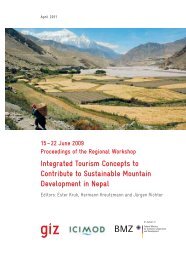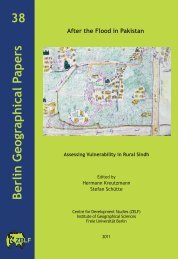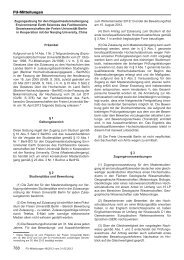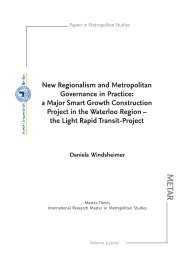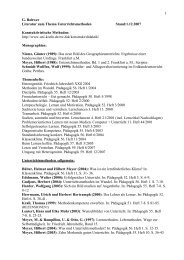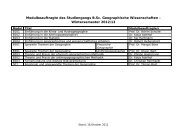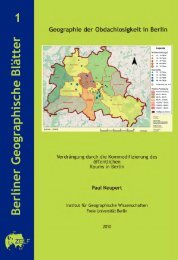Pastoralism and Rangeland Management on the Tibetan Plateau in ...
Pastoralism and Rangeland Management on the Tibetan Plateau in ...
Pastoralism and Rangeland Management on the Tibetan Plateau in ...
You also want an ePaper? Increase the reach of your titles
YUMPU automatically turns print PDFs into web optimized ePapers that Google loves.
5.2 Integrat<strong>in</strong>g Agricultural <str<strong>on</strong>g>and</str<strong>on</strong>g> Pastoral<br />
Resources for Poverty Alleviati<strong>on</strong> <str<strong>on</strong>g>and</str<strong>on</strong>g> Reduc<strong>in</strong>g<br />
Eco-pressure <strong>on</strong> Rangel<str<strong>on</strong>g>and</str<strong>on</strong>g>s<br />
Wang Jian 53<br />
Abstract<br />
Today people are pay<strong>in</strong>g more attenti<strong>on</strong> to pastoralism <str<strong>on</strong>g>and</str<strong>on</strong>g> rangel<str<strong>on</strong>g>and</str<strong>on</strong>g> management<br />
<strong>on</strong> <strong>the</strong> <strong>Tibetan</strong> <strong>Plateau</strong> not because of <strong>the</strong> delicious meat <str<strong>on</strong>g>and</str<strong>on</strong>g> milk<br />
produced <strong>the</strong>re, nor <strong>the</strong> attractive scenery, but ra<strong>the</strong>r because of its changed<br />
functi<strong>on</strong> as a global ecological shelter. The livelihoods of pastoralists who have<br />
lived here for generati<strong>on</strong>s are relatively weak <str<strong>on</strong>g>and</str<strong>on</strong>g> large herds are putt<strong>in</strong>g <strong>in</strong>creas<strong>in</strong>g<br />
pressure <strong>on</strong> <strong>the</strong> rangel<str<strong>on</strong>g>and</str<strong>on</strong>g> ecosystem. It all happened under <strong>the</strong> backdrop of<br />
<strong>the</strong> government’s c<strong>on</strong>t<strong>in</strong>ued efforts to promote <strong>the</strong> development of <strong>the</strong> plateau<br />
pastoralist communities. This means that we have to reflect <strong>on</strong> <strong>the</strong> mode of operati<strong>on</strong><br />
<strong>in</strong> pastoralism that is characterized by poverty, underdevelopment <str<strong>on</strong>g>and</str<strong>on</strong>g><br />
a lack of eco-friendl<strong>in</strong>ess. This article aims to propose suggesti<strong>on</strong>s for pastoral<br />
practices that utilize <strong>the</strong> resources of agricultural communities to help reduce<br />
poverty <strong>in</strong> pastoralist communities by first re-c<strong>on</strong>ceptualiz<strong>in</strong>g traditi<strong>on</strong>al<br />
pastoralism, <strong>the</strong>n analyz<strong>in</strong>g <strong>the</strong> causes of poverty <strong>in</strong> pastoral areas <str<strong>on</strong>g>and</str<strong>on</strong>g> lastly<br />
study<strong>in</strong>g <strong>the</strong> specific case of an <strong>in</strong>tegrated agricultural-pastoral development<br />
model <str<strong>on</strong>g>and</str<strong>on</strong>g> its feasibility.<br />
1 Introducti<strong>on</strong><br />
In Nagqu Prefecture of Tibet, between May <str<strong>on</strong>g>and</str<strong>on</strong>g> June of 2008, an untimely<br />
snowfall delayed <strong>the</strong> grass from turn<strong>in</strong>g green. The subsequent lack of fodder<br />
became <strong>the</strong> last straw that destroyed <strong>the</strong> already weak herds. 260,000 heads of<br />
cattle wi<strong>the</strong>red away. Local pastoralists suffered an ec<strong>on</strong>omic loss of hundreds<br />
of milli<strong>on</strong>s of Yuan. After <strong>the</strong> disaster, what did we do? Did we do anyth<strong>in</strong>g to<br />
prepare ourselves for <strong>the</strong> next big disaster? Obviously we can’t say that noth<strong>in</strong>g<br />
was d<strong>on</strong>e. In <strong>the</strong> past two years, <strong>the</strong> government completed <strong>the</strong> c<strong>on</strong>structi<strong>on</strong> of<br />
houses for <strong>the</strong> pastoralist resettlement programme <str<strong>on</strong>g>and</str<strong>on</strong>g> <strong>the</strong> sheds for livestock<br />
<str<strong>on</strong>g>and</str<strong>on</strong>g> fodder. The government c<strong>on</strong>t<strong>in</strong>ues to support <strong>the</strong> restorati<strong>on</strong> of pasture<br />
<str<strong>on</strong>g>and</str<strong>on</strong>g> fenc<strong>in</strong>g projects. Small-scale cultivati<strong>on</strong> of pastures is be<strong>in</strong>g carried out.<br />
In additi<strong>on</strong>, a pilot programme of payment for rangel<str<strong>on</strong>g>and</str<strong>on</strong>g> ecosystem services<br />
53 Poverty Alleviati<strong>on</strong> Office of TAR, Lhasa<br />
225<br />
> > > 5. Pastoral Practices <str<strong>on</strong>g>and</str<strong>on</strong>g> <strong>the</strong>ir Transformati<strong>on</strong>s



